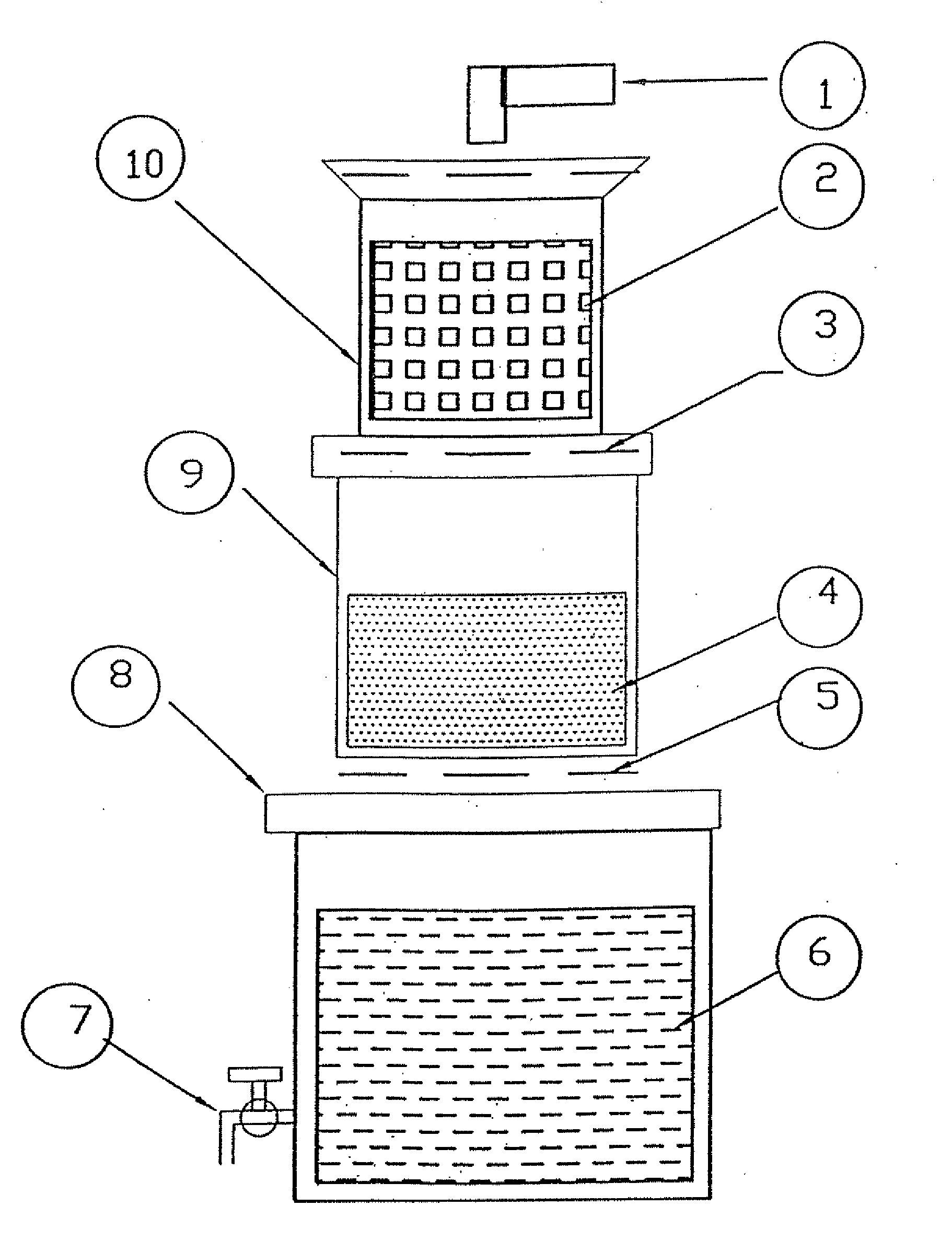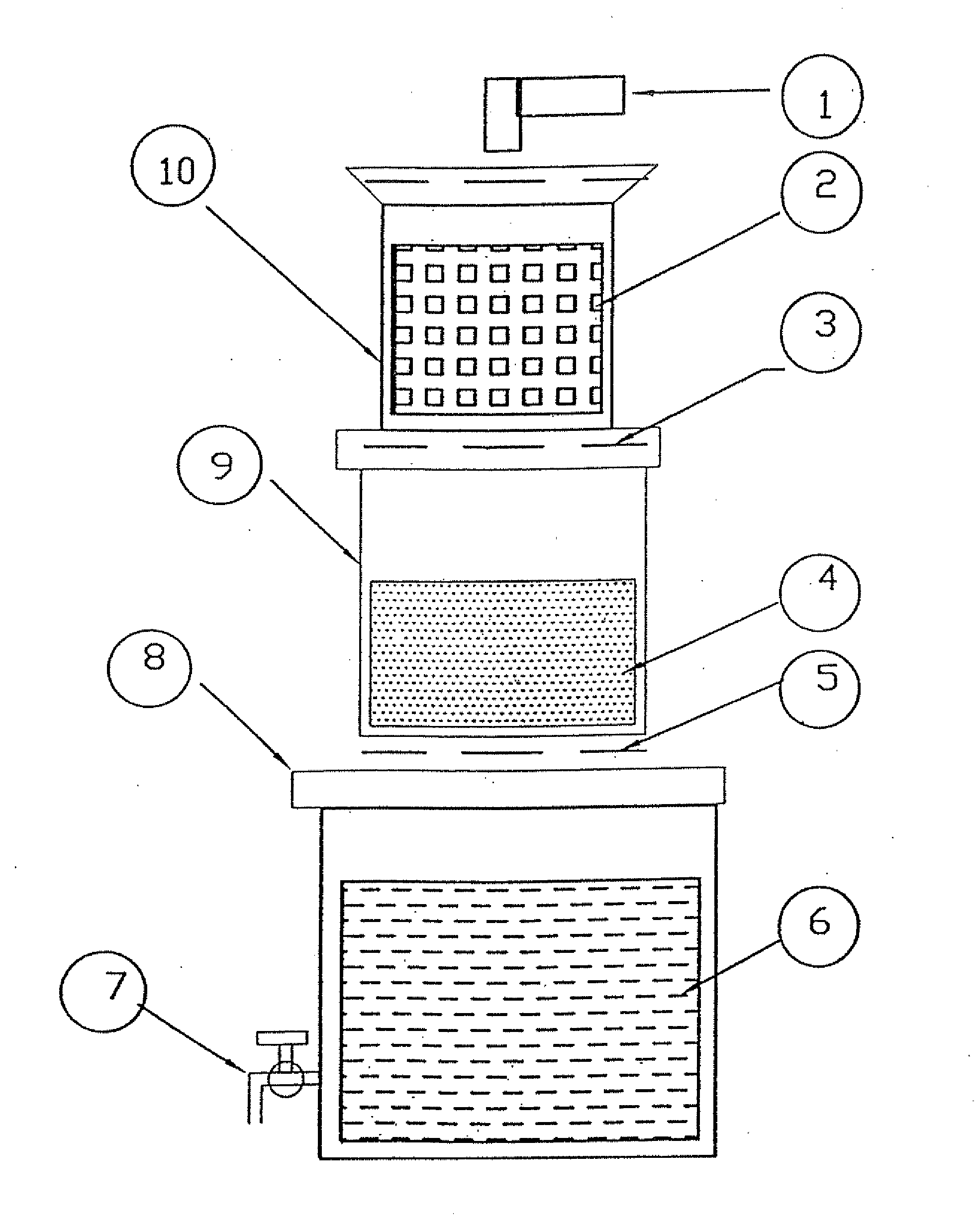Filtering Device for the Removal of Arsenic from Water
a filtering device and arsenic technology, applied in water cleaning, multi-stage water/sewage treatment, separation processes, etc., can solve the problems of arsenic poisoning of ground/surface water, serious health hazards, and affecting approximately 90 million people, and achieves low price and low cost.
- Summary
- Abstract
- Description
- Claims
- Application Information
AI Technical Summary
Benefits of technology
Problems solved by technology
Method used
Image
Examples
example-1
[0041]In the first experiment, synthetic solution of 1:1 mixture of Arsenics (III) & Arsenic (V) part per million total concentration) was prepared in water and stored. This synthetics solution was passed at a flow rate of 15 liters / hour through the first chamber containing 500 grams of steel wool, followed by filtration though second chamber containing 1500 grams of treated sand. The water filtered through sand was stored in the lower most chamber and was free from Arsenic and other undesirable contaminants. The details of actual quantities of steel wool, and treated river sand required for the filtering and optimization of flow rate are shown below.
1.Steel wool (Steel plant waste)500 gms2.Treated Sand1500 gms3.Flow rate15 lit. / hr4.Initial Arsenic conc. Range1 ppm (1:1 mixture ofAS(III) and AS(V))5.Final Arsenic s Conc.WHO's drinking water limitof 10 parts per billion)6.Volume of water treated750 lits.7.Quality of waterSuitable for drinkingpurpose.8.Leaching of other metalsNo leach...
example-2
[0042]In the second such experiment, synthetic solution of 1:1 mixture of Arsenic (III) & Arsenic (V) (1 parts per million total concentration) was prepared in water and stored in reservoir. This solution was passed at the flow rate of 30 liters / hour through the first chamber containing 1000 grams of steel wool followed by filtration though second chamber containing 3000 grams of washed and air-dried sand. The water filtered through sand was stored in the lower most chamber which was free from Arsenic and other undesirable contaminants. The details of actual quantities of steel wool, and treated river sand required for the filtering and optimization of flow rate are shown below.
1.Adsorbent (Steel plant waste)1000 gms2.Treated Sand3000 gms3.Flow rate30 lit. / hr4.Initial As conc. Range1 ppm (1:1 mixture ofAS(III) and AS(V))5.Final As Conc.WHO's drinking water limitof 10 part per billion)6.Volume of water treated1600 lits.7.Quality of waterSuitable for drinkingpurpose.8.Leaching of othe...
PUM
| Property | Measurement | Unit |
|---|---|---|
| flow rate | aaaaa | aaaaa |
| flow rate | aaaaa | aaaaa |
| adsorption | aaaaa | aaaaa |
Abstract
Description
Claims
Application Information
 Login to View More
Login to View More - R&D
- Intellectual Property
- Life Sciences
- Materials
- Tech Scout
- Unparalleled Data Quality
- Higher Quality Content
- 60% Fewer Hallucinations
Browse by: Latest US Patents, China's latest patents, Technical Efficacy Thesaurus, Application Domain, Technology Topic, Popular Technical Reports.
© 2025 PatSnap. All rights reserved.Legal|Privacy policy|Modern Slavery Act Transparency Statement|Sitemap|About US| Contact US: help@patsnap.com


